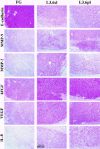In vivo selection and characterization of metastatic variants from human pancreatic adenocarcinoma by using orthotopic implantation in nude mice
- PMID: 10935470
- PMCID: PMC1764837
- DOI: 10.1038/sj.neo.7900005
In vivo selection and characterization of metastatic variants from human pancreatic adenocarcinoma by using orthotopic implantation in nude mice
Abstract
We determined whether the implantation of human pancreatic cancer cells into the pancreas of nude mice can be used to select variants with increasing metastatic potential. COLO 357 line fast-growing cells were injected into the spleen or pancreas of nude mice. Hepatic metastases were harvested, and tumor cells were reinjected into the spleen or pancreas. This cycle was repeated several times to yield cell lines L3.6sl (spleen to liver) and L3.6pl (pancreas to liver). The variant cells produced significantly higher incidence and number of lymph node and liver metastases than the parental cells. Their increased metastatic potential was associated with increased expression (mRNA and protein) of the proangiogenic molecules basic fibroblast growth factor, vascular endothelial growth factor, and interleukin-8. The metastatic cells also exhibited increased motility and invasiveness, which were associated with increased expression of collagenase type IV (MMP-9) and decreased expression of E-cadherin. Collectively, the data show that the orthotopic implantation of human pancreatic cancer cells in nude mice is a relevant model with which to study the biology of pancreatic cancer metastasis and to select variant cell lines with enhanced metastatic potential.
Figures





References
-
- Moore M. Clinical experience with gemcitabine in pancreatic cancer. Oncology. 1997;11:1615–1622. - PubMed
-
- Wanebo HJ, Vezeridis MP. Pancreatic carcinoma in perspective. A continuing challenge. Cancer. 1996;78(Suppl):580–591. - PubMed
-
- Moore M. Activity of gemcitabine in patients with advanced pancreatic cancer. Cancer. 1996;78(Suppl):633–638. - PubMed
-
- Rothenberg ML, Abbruzzese JL, Portenoy RK, Robertson JM, Wanebo HJ. A rationale for expanding the endpoints for clinical trials in advanced pancreatic cancer. Cancer. 1996;78(Suppl):627–632. - PubMed
-
- Bramhall SR. The use of molecular technology in the differentiation of pancreatic cancer and pancreatitis. Int J Pancreatol. 1998;23:83–100. - PubMed
MeSH terms
Substances
Grants and funding
LinkOut - more resources
Full Text Sources
Other Literature Sources
Medical
Research Materials
Miscellaneous
